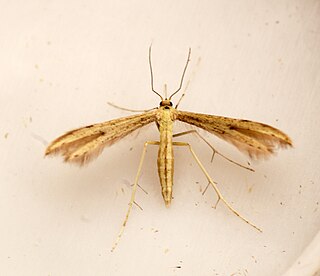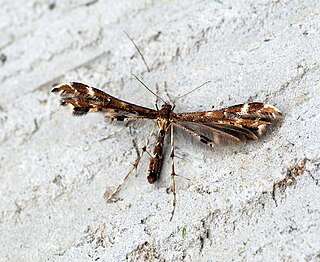
The Pterophoridae or plume moths are a family of Lepidoptera with unusually modified wings, giving them the shape of a narrow winged airplane. Though they belong to the Apoditrysia like the larger moths and the butterflies, unlike these they are tiny and were formerly included among the assemblage called "microlepidoptera".

Stenoptilia bipunctidactyla, also known as the twin-spot plume is a moth of the Pterophoroidea family found in North Africa, Asia and Europe. It was first described by the Austrian physician and naturalist, Giovanni Antonio Scopoli in 1763. It is one of four similar looking moths.

Gillmeria pallidactyla is a moth of the family Pterophoridae first described by the English entomologist, Adrian Hardy Haworth in 1811. It has a Holarctic distribution and is widespread throughout North America and the Palearctic.

Hellinsia osteodactyla is a moth of the family Pterophoridae. It is found in most of Europe, as well as North Africa and from Asia Minor to Japan. Also known as the small golden-rod plume it was first described by Philipp Christoph Zeller in 1841.

Hellinsia tephradactyla is a moth of the family Pterophoridae found in most of Europe. It was first described by the German taxonomist Jacob Hübner in 1813.

Platyptilia isodactylus is a moth of the family Pterophoridae found in China, Europe and was introduced to Australia and New Zealand for biological control. It was first described by the German entomologists, Philipp Christoph Zeller in 1852.

Agdistis meridionalis, the sea-side plume, is a moth of the family Pterophoridae, first described by the German entomologist Philipp Christoph Zeller in 1847. It is found in Europe.

Oidaematophorus lithodactyla, also known as the dusky plume, is a moth of the family Pterophoridae found from Europe to Asia Minor and Japan. It was first described by German lepidopterist, Georg Friedrich Treitschke in 1833.

Adaina microdactyla is a moth of the family Pterophoridae first described by Jacob Hübner in 1813. Also known as the hemp-agrimony plume, it is found in Africa, Asia and Europe.

Crombrugghia is a genus of moths in the family Pterophoridae. It was erected by James William Tutt in 1906.
Agdistis tamaricis is a moth of the family Pterophoridae found in Africa, Asia and Europe. It was first described by the German entomologist, Philipp Christoph Zeller in 1847.

Oxyptilus parvidactyla, also known as the small plume, is a moth of the family Pterophoridae found in Africa, America latina, Asia and Europe. It was first described by Adrian Hardy Haworth in 1811.

Crombrugghia distans, also known as the Breckland plume is a moth of the family Pterophoridae found in Africa, Asia and Europe. It was first described by Philipp Christoph Zeller in 1847.

Capperia britanniodactylus, also known as the wood sage plume is a moth of the family Pterophoridae, found in Europe. It was first described by Charles Stuart Gregson in 1869.

Merrifieldia leucodactyla, also known as the thyme plume, is a moth of the family Pterophoridae, and is known from most of Europe, as well as North Africa and Asia Minor. It was first described by the Austrian lepidopterists, Michael Denis and Ignaz Schiffermüller in 1775).

Merrifieldia baliodactylus, also known as the dingy white plume, is a moth of the family Pterophoridae found in most of Europe. It was first described by the German entomologist, Philipp Christoph Zeller in 1841.

Crombrugghia tristis is a moth of the family Pterophoridae. It is found in most of Europe, except the Benelux, Great Britain, Ireland and Scandinavia. It is also known from southern Siberia, Asia Minor and central Asia. The habitat consists of sandy areas overgrown with Hieracium.
Hellinsia elliottii is a moth of the family Pterophoridae. It is found in North America, including Mississippi, New York, Iowa, Quebec, Alberta and Ontario.
Agdistopis sinhala is a moth of the family Macropiratidae. It is found in south-east Asia, including Sri Lanka, India, Japan and Taiwan.

Agonopterix conterminella is a moth of the family Depressariidae which is found in Asia, Europe and North America. It was described by Philipp Christoph Zeller in 1839 from a specimen found in Augsburg, Germany. The larvae feed on the terminal shoots of willows.

















